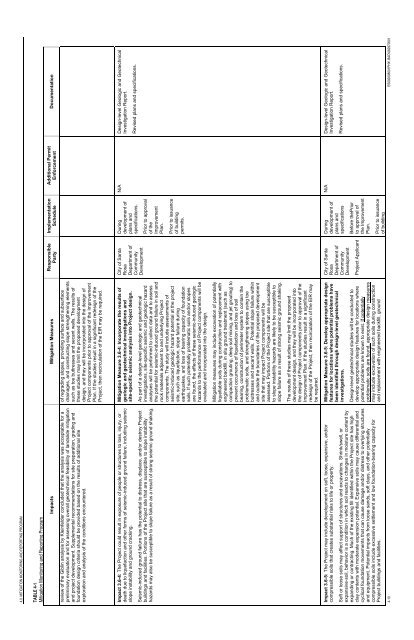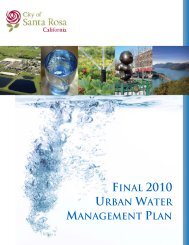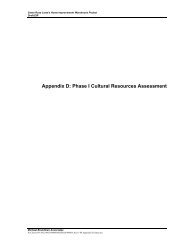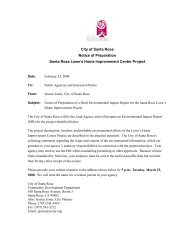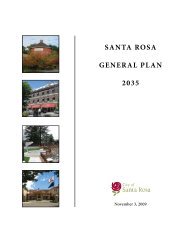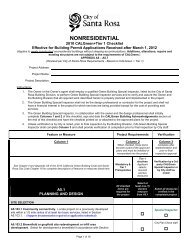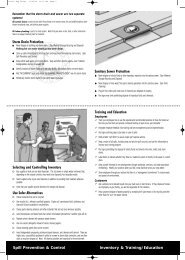Fountaingrove Environmental Impact Report - City of Santa Rosa ...
Fountaingrove Environmental Impact Report - City of Santa Rosa ...
Fountaingrove Environmental Impact Report - City of Santa Rosa ...
Create successful ePaper yourself
Turn your PDF publications into a flip-book with our unique Google optimized e-Paper software.
4.0 MITIGATION MONITORING AND REPORTING PROGRAM<br />
TABLE 4-1<br />
Mitigation Monitoring and <strong>Report</strong>ing Program<br />
Documentation<br />
Additional Permit<br />
Enforcement<br />
Implementation<br />
Schedule<br />
<strong>Impact</strong>s Mitigation Measures Responsible<br />
Party<br />
<strong>of</strong> regrading slopes, providing surface and subsurface<br />
drainages, and constructing slope strengthening elements<br />
such as toe buttresses and secant walls. The results <strong>of</strong><br />
these studies may limit the proposed development<br />
design, and they will be incorporated into the design <strong>of</strong><br />
Project components prior to approval <strong>of</strong> the Improvement<br />
Plan. If the studies result in a significant redesign <strong>of</strong> the<br />
Project, then recirculation <strong>of</strong> the EIR may be required.<br />
review <strong>of</strong> the Giblin analysis by Kleinfelder concluded that the analysis was acceptable for a<br />
preliminary evaluation and for assessing overall geotechnical feasibility <strong>of</strong> landslide mitigation<br />
and project development. Supplemental recommendations for site preparation, grading and<br />
foundation design criteria should be provided based on the results <strong>of</strong> additional site<br />
exploration and analysis <strong>of</strong> the conditions encountered.<br />
N/A Design-level Geologic and Geotechnical<br />
Investigation <strong>Report</strong>.<br />
During<br />
development <strong>of</strong><br />
plans and<br />
specifications.<br />
<strong>City</strong> <strong>of</strong> <strong>Santa</strong><br />
<strong>Rosa</strong><br />
Department <strong>of</strong><br />
Community<br />
Development<br />
Mitigation Measure 3.6-4: Incorporate the results <strong>of</strong><br />
geologic and geotechnical investigations and<br />
site-specific seismic analysis into Project design.<br />
<strong>Impact</strong> 3.6-4: The Project could result in exposure <strong>of</strong> people or structures to loss, injury, or<br />
death due to liquefaction and other forms <strong>of</strong> seismic-induced ground failure, including seismic<br />
slope instability and ground cracking.<br />
Revised plans and specifications.<br />
Prior to approval<br />
<strong>of</strong> the<br />
Improvement<br />
Plan.<br />
As part <strong>of</strong> a design-level geologic and geotechnical<br />
investigations, site-specific seismic and geologic hazard<br />
analyses will be performed to collect data and to assess<br />
the potential for seismic-induced ground failure in soil and<br />
rock materials adjacent to and underlying Project<br />
components. The study will include assessments <strong>of</strong><br />
seismic-induced geologic hazard potential at the project<br />
site, such as liquefaction, slope failure during<br />
earthquakes, and loss <strong>of</strong> bearing capacity <strong>of</strong> foundation<br />
soils. If such potentially problematic soils and/or slopes<br />
are found, the effects <strong>of</strong> these seismic-induced geologic<br />
hazards to the performance <strong>of</strong> Project components will be<br />
evaluated and incorporated into the design.<br />
Seismic-induced ground failure has the potential to distress, displace, and/or destroy Project<br />
buildings and facilities. Portions <strong>of</strong> the Project site that are susceptible to slope instability<br />
hazards may also be susceptible to slope failure as a result <strong>of</strong> strong seismic ground shaking.<br />
Prior to issuance<br />
<strong>of</strong> building<br />
permits.<br />
Mitigation measures may include excavation <strong>of</strong> potentially<br />
liquefiable soils during construction and replacement with<br />
engineered backfill, in situ ground treatment (such as<br />
compaction grouting, deep soil mixing, and jet grouting) to<br />
prevent occurrence <strong>of</strong> liquefaction and loss <strong>of</strong> soil<br />
bearing, construction <strong>of</strong> perimeter system to contain the<br />
problematic soils, and strengthening slopes using toe<br />
buttresses and secant walls. Potential slope failure within<br />
and outside the boundaries <strong>of</strong> the proposed development<br />
site that may impact Project components will be<br />
assessed. Portions <strong>of</strong> the Project site that are susceptible<br />
to slope instability hazards are likely to be susceptible to<br />
slope failure as a result <strong>of</strong> strong seismic ground shaking.<br />
The results <strong>of</strong> these studies may limit the proposed<br />
development design, and they will be incorporated into<br />
the design <strong>of</strong> Project components prior to approval <strong>of</strong> the<br />
Improvement Plan. If the studies result in a significant<br />
redesign <strong>of</strong> the Project, then recirculation <strong>of</strong> the EIR may<br />
be required.<br />
<strong>Impact</strong> 3.6-5: The Project may include development on s<strong>of</strong>t, loose, expansive, and/or Mitigation Measure 3.6-5: Develop appropriate design <strong>City</strong> <strong>of</strong> <strong>Santa</strong> During<br />
N/A Design-level Geologic and Geotechnical<br />
compressible soils that creates substantial risks to life or property.<br />
features for locations where potential problems have <strong>Rosa</strong><br />
development <strong>of</strong><br />
Investigation <strong>Report</strong>.<br />
been identified through design-level geotechnical Department <strong>of</strong> plans and<br />
S<strong>of</strong>t or loose soils may affect support <strong>of</strong> structures and excavations. Shrink/swell, or<br />
investigations.<br />
Community specifications<br />
Revised plans and specifications.<br />
expansive-soil, behavior is a condition in which soil reacts to changes in moisture content by<br />
Development<br />
expanding or contracting. Much <strong>of</strong> the existing fill identified within the Project site has high Design-level geotechnical studies will be conducted to<br />
Before thePrior<br />
clay contents with moderate expansion potential. Expansive soils may cause differential and develop appropriate design features for locations where Project Applicant to approval <strong>of</strong><br />
cyclical foundation movements that can cause damage and/or distress to overlying structures potential problems are known to exist. If potentially<br />
the Improvement<br />
and equipment. Potential impacts from loose sands, s<strong>of</strong>t clays, and other potentially<br />
problematic soils are found, appropriate design measures<br />
Plan.<br />
compressible soils include excessive settlement and low foundation-bearing capacity for may include excavation <strong>of</strong> such soils during construction<br />
Project buildings and facilities.<br />
and replacement with engineered backfill, ground<br />
Prior to issuance<br />
<strong>of</strong> building<br />
4-10 ES092008001PHX\ BAO\082970001


